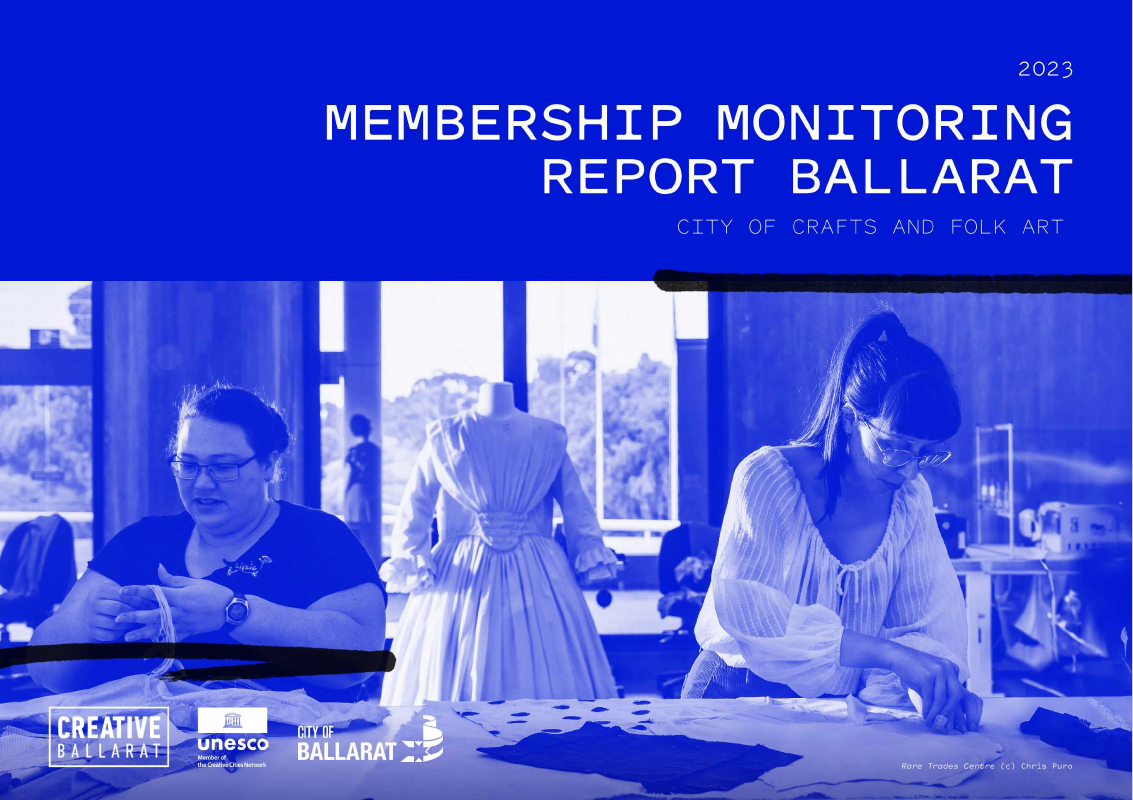Wadawurrung traditional custodian Tammy Gilson pic by Far Flung Films
A UNESCO Creative City
Ballarat was designated a UNESCO Creative City of Crafts and Folk Art in 2019. This important designation focuses our city’s attention on the development of a resilient and sustainable creative sector, with a specific focus on crafts and folk art. We concentrate upon ceramics, textiles and placing First Nations people first on the retracing of lost skills.
We are proud to be invited to share in the knowledge of Wadawurrung and Dja Dja Wurrung peoples, on whose land Ballarat sits. Working in close collaboration with representatives of Traditional Owner communities, and all other Aboriginal and Torres Strait Islander groups who call Ballarat their home, we seek to work to support the sharing, documentation and act as witness to the reinstatement of traditional crafts.
The designation has helped us reveal and celebrate our 150-year-old Federation University, home to one of Australia’s oldest art schools. It has helped us to uncover and identify professional artisans, supporting them in establishing financial resilience and building our capacity as a creative city. Most importantly it gives us a chance to celebrate skills and talents, capturing the cultural heart of Ballarat.
reporting on our first four years as a creative city
As part of our UNESCO Creative City obligations, Ballarat must report on its creative city initiatives and explain what’s worked and what hasn’t. 2023 is the first year of our reporting. Check out what we’ve achieved and what our plans are for the future.
Cassy Macarthur demonstrates her work, and explains the importance of the UNESCO Creative City designation
Produced by Far Flung Films, with original score by Lachlan Mansell and Isabella Bradbeer
Jeweller Rachel Grose at work, image (c) Tony Evans 2022
About the UNESCO Creative Cities Network
The UNESCO Creative Cities Network in Australia covers six creative fields: Crafts and Folk Art (Ballarat), Design (Geelong), Film (Sydney), Gastronomy (Bendigo), Literature (Melbourne) and Music (Adelaide).
Objectives
The UNESCO Creative Cities Network aims to:
strengthen international cooperation between cities that have recognized creativity as a strategic factor of their sustainable development;
stimulate and enhance initiatives led by member cities to make creativity an essential component of urban development, notably through partnerships involving the public and private sectors and civil society.
strengthen the creation, production, distribution and dissemination of cultural activities, goods and services;
develop hubs of creativity and innovation and broaden opportunities for creators and professionals in the cultural sector;
improve access to and participation in cultural life as well as the enjoyment of cultural goods and services, notably for marginalized or vulnerable groups and individuals;
fully integrate culture and creativity into local development strategies and plans.
A heritage city.
A creative city.
Ballarat is a city of diverse peoples on traditional land. Our city is a location made up of diverse creative skills with a chequered and layered history. This special heritage has left us with a complex web of crafts that have been used to tell the tale of an indigenous nation, a goldrush city and today a city of varied groups of migrants gathered, travelling through, or embedded over the last 200 years.
Additionally, our city is preparing for influx and growth into the future. We seek to capture the craft and skills of new peoples arriving.
Our commitment to a vision of a Creative City of Crafts and Folk Art falls under four key pillars:
Pillar 1 -
Creative a new economic heartbeat: Crafts and folk art have helped our city survive throughout time. We have a responsibility to harness these skills and create environments where we can support practitioners to become sustainable.
Pillar 2 -
Celebrating, protecting and reinterpreting the rare and forgotten crafts: Heritage is critical for our city. Rare crafts, fine skills and artisanal experience are important to conserve, preserve and research.
Pillar 3 -
A welcome platform for newer community members: As a Creative City of Craft and Folk Art we seek to integrate and harness knowledge, growing new trades and sectors, sustaining and broadening skills.
Pillar 4 -
Reinvigorating the skills of indigenous communities: with a traceable heritage of more than 65,000 years, the skills and crafts of indigenous peoples of the Wadawarrung, the Dja Dja Warrung and others from the Kulin nation, have been severely interrupted. We are dedicated to putting First Nations peoples first in tracing these crafts back, reawakening old craft forms and putting them at the heart of the craft-based city.
Weaver Ana Peditis in her studio
Ceramics by artist, Claire Blake
Textile artist Jem Olsen at work







